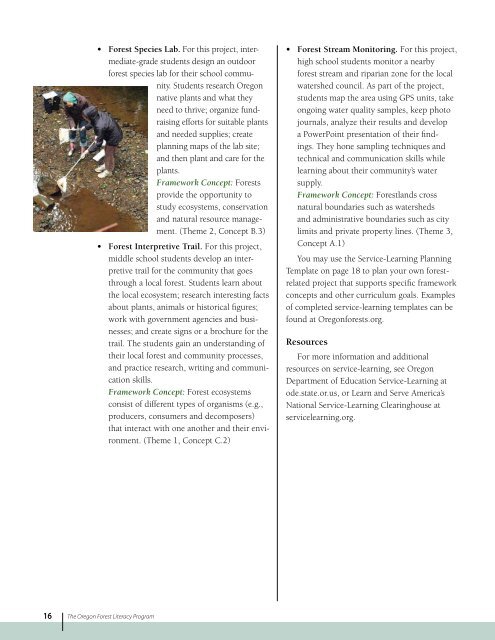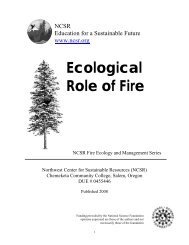Oregon Forest Literacy Program (PDF) - Learn Forests
Oregon Forest Literacy Program (PDF) - Learn Forests
Oregon Forest Literacy Program (PDF) - Learn Forests
Create successful ePaper yourself
Turn your PDF publications into a flip-book with our unique Google optimized e-Paper software.
<strong>Forest</strong> Species Lab. For this project, intermediate-grade<br />
students design an outdoor<br />
forest species lab for their school community.<br />
Students research <strong>Oregon</strong><br />
native plants and what they<br />
need to thrive; organize fundraising<br />
efforts for suitable plants<br />
and needed supplies; create<br />
planning maps of the lab site;<br />
and then plant and care for the<br />
plants.<br />
Framework Concept: <strong>Forest</strong>s<br />
provide the opportunity to<br />
study ecosystems, conservation<br />
and natural resource management.<br />
(Theme 2, Concept B.3)<br />
<strong>Forest</strong> Interpretive Trail. For this project,<br />
middle school students develop an interpretive<br />
trail for the community that goes<br />
through a local forest. Students learn about<br />
the local ecosystem; research interesting facts<br />
about plants, animals or historical figures;<br />
work with government agencies and businesses;<br />
and create signs or a brochure for the<br />
trail. The students gain an understanding of<br />
their local forest and community processes,<br />
and practice research, writing and communication<br />
skills.<br />
Framework Concept: <strong>Forest</strong> ecosystems<br />
consist of different types of organisms (e.g.,<br />
producers, consumers and decomposers)<br />
that interact with one another and their environment.<br />
(Theme 1, Concept C.2)<br />
<strong>Forest</strong> Stream Monitoring. For this project,<br />
high school students monitor a nearby<br />
forest stream and riparian zone for the local<br />
watershed council. As part of the project,<br />
students map the area using GPS units, take<br />
ongoing water quality samples, keep photo<br />
journals, analyze their results and develop<br />
a PowerPoint presentation of their findings.<br />
They hone sampling techniques and<br />
technical and communication skills while<br />
learning about their community’s water<br />
supply.<br />
Framework Concept: <strong>Forest</strong>lands cross<br />
natural boundaries such as watersheds<br />
and administrative boundaries such as city<br />
limits and private property lines. (Theme 3,<br />
Concept A.1)<br />
You may use the Service-<strong>Learn</strong>ing Planning<br />
Template on page 18 to plan your own forestrelated<br />
project that supports specific framework<br />
concepts and other curriculum goals. Examples<br />
of completed service-learning templates can be<br />
found at <strong>Oregon</strong>forests.org.<br />
Resources<br />
For more information and additional<br />
resources on service-learning, see <strong>Oregon</strong><br />
Department of Education Service-<strong>Learn</strong>ing at<br />
ode.state.or.us, or <strong>Learn</strong> and Serve America’s<br />
National Service-<strong>Learn</strong>ing Clearinghouse at<br />
servicelearning.org.<br />
16 The <strong>Oregon</strong> <strong>Forest</strong> <strong>Literacy</strong> <strong>Program</strong>



